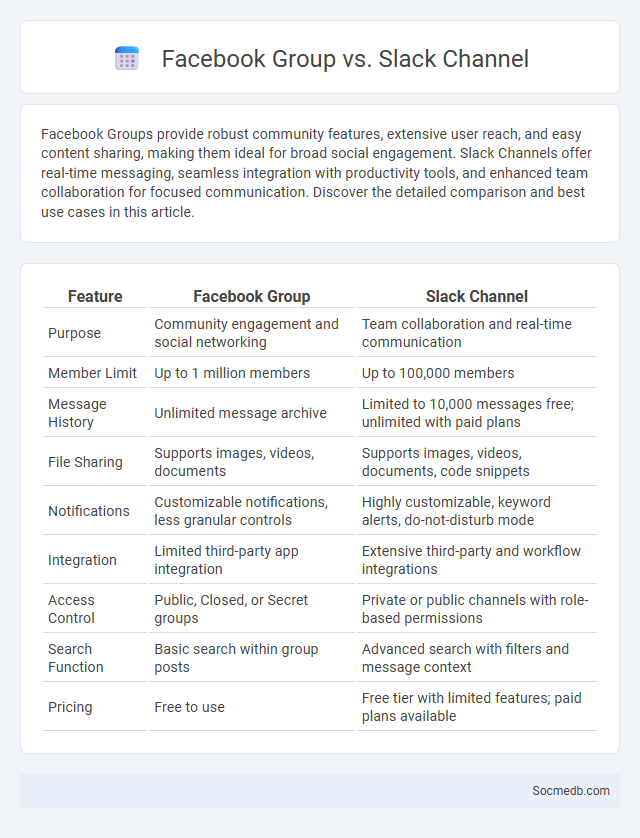
Photo illustration: Facebook Group vs Slack Channel
Facebook Groups provide robust community features, extensive user reach, and easy content sharing, making them ideal for broad social engagement. Slack Channels offer real-time messaging, seamless integration with productivity tools, and enhanced team collaboration for focused communication. Discover the detailed comparison and best use cases in this article.
Table of Comparison
| Feature | Facebook Group | Slack Channel |
|---|---|---|
| Purpose | Community engagement and social networking | Team collaboration and real-time communication |
| Member Limit | Up to 1 million members | Up to 100,000 members |
| Message History | Unlimited message archive | Limited to 10,000 messages free; unlimited with paid plans |
| File Sharing | Supports images, videos, documents | Supports images, videos, documents, code snippets |
| Notifications | Customizable notifications, less granular controls | Highly customizable, keyword alerts, do-not-disturb mode |
| Integration | Limited third-party app integration | Extensive third-party and workflow integrations |
| Access Control | Public, Closed, or Secret groups | Private or public channels with role-based permissions |
| Search Function | Basic search within group posts | Advanced search with filters and message context |
| Pricing | Free to use | Free tier with limited features; paid plans available |
Introduction: The Evolution of Online Collaboration
Social media has transformed online collaboration by enabling real-time communication and seamless content sharing across global networks. Platforms like Facebook, Twitter, and LinkedIn facilitate diverse interactions, from professional networking to community building. Advanced features such as live streaming, group chats, and collaborative workspaces continue to enhance interactive and collective experiences in digital environments.
What is a Facebook Group?
A Facebook Group is an online community feature designed to bring people together around shared interests, goals, or topics. It allows members to post content, engage in discussions, and collaborate within a controlled environment, which can be public, closed, or secret based on privacy settings. Your participation in a Facebook Group enables direct interaction with like-minded individuals, fostering meaningful connections and knowledge exchange.
What is a Slack Channel?
A Slack channel is a dedicated space within the Slack platform designed for team communication and collaboration, organized around specific topics, projects, or departments. Channels can be public for company-wide participation or private for restricted team conversations, enabling efficient information sharing and real-time messaging. You can customize notifications and integrate tools to streamline workflows and enhance productivity within your organization.
What is a Group (General Definition)?
A group on social media is a collection of users connected by shared interests, goals, or communities within a platform, allowing members to communicate, share content, and collaborate in a focused environment. Groups can be public, private, or secret, offering varying levels of privacy and member access depending on the platform's settings. Your participation in these groups enhances networking opportunities and fosters engagement around specific topics or causes.
Key Features Comparison
Social media platforms vary widely in key features such as content formats, user engagement tools, and privacy settings. Instagram emphasizes visual content with robust photo and video sharing options, while Twitter specializes in real-time text updates and trending topic discussions. Facebook offers a comprehensive suite including groups, events, marketplace, and detailed user profiles, enabling diverse interaction and community building.
User Experience and Interface
A seamless social media user experience prioritizes intuitive navigation, fast loading times, and personalized content to keep your engagement high. Optimizing the user interface with clear visuals, consistent design elements, and accessible features ensures users interact effortlessly across devices. Enhancing these aspects reduces bounce rates and boosts overall satisfaction by making your social media platform enjoyable and efficient.
Privacy and Security Considerations
Social media platforms collect vast amounts of personal data, making privacy settings crucial for protecting your information from unauthorized access. Understanding encryption protocols and enabling two-factor authentication significantly enhance your account security against cyber threats. Regularly reviewing permissions granted to third-party apps helps minimize data exposure and safeguards your digital footprint.
Community Engagement and Management
Community engagement and management in social media involve strategizing to foster authentic interactions between brands and users, enhancing loyalty and trust. Effective management utilizes analytics tools to monitor audience sentiment, respond promptly to feedback, and tailor content that resonates with diverse demographics. Consistent engagement through personalized communication and community-driven initiatives significantly boosts brand visibility and customer retention.
Use Cases: Which Platform Fits Your Needs?
Selecting the right social media platform depends on your specific use cases and target audience. For visual storytelling and brand awareness, Instagram and TikTok offer strong engagement through images and short videos, while LinkedIn excels for professional networking and B2B marketing. Your content strategy should align with platform strengths to maximize reach and interaction.
Conclusion: Choosing the Right Platform for Your Community
Selecting the ideal social media platform for your community depends on understanding your audience's demographics and engagement preferences. Platforms like Facebook, Instagram, LinkedIn, and TikTok offer distinct features that cater to different content types and user interactions. Your success hinges on aligning platform strengths with your community's needs to foster meaningful connections and sustained growth.
 socmedb.com
socmedb.com